Specific ingredients define popular types of pancit.
Pancit Bihon, Pancit Canton, and Pancit Lomi are distinct due to their unique combinations of noodles, proteins, and vegetables.
Pancit Bihon features thin rice noodles, whereas Pancit Canton uses egg noodles.
Pancit Lomi combines thick egg noodles with a blend of Filipino and Chinese influences.
These varying ingredients contribute to their unique flavor profiles and textures.
Defining Pancit Canton Varieties
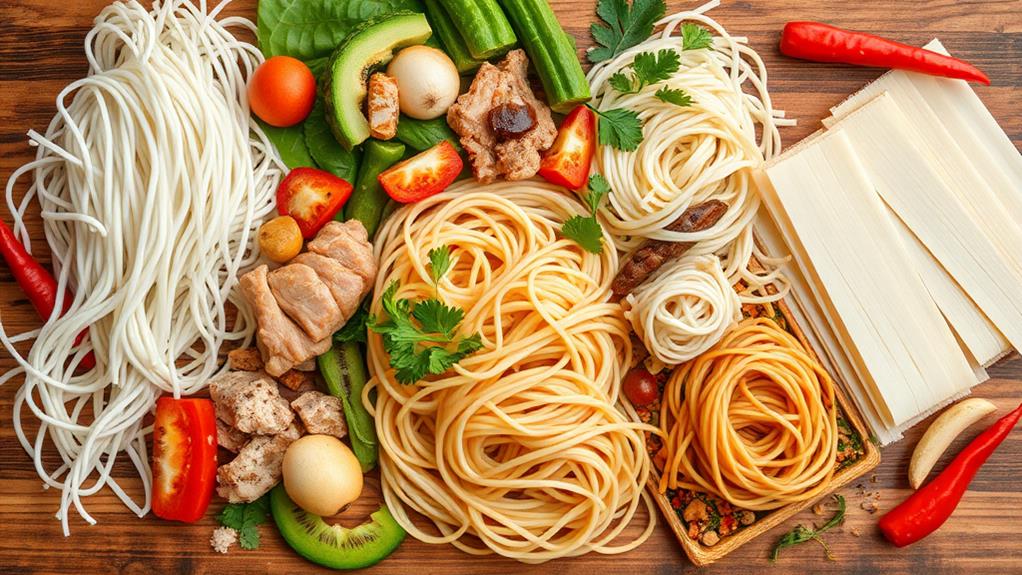
Pancit Canton varieties are distinguished by their unique flavor profiles, which result from varying combinations of ingredients.
Pancit Canton is defined by its use of egg noodles, which provide a chewier texture compared to rice noodles used in other pancit varieties. The dish typically features a savory flavor profile, achieved through the combination of soy sauce and oyster sauce, which creates a rich and umami taste.
Proteins commonly used in Pancit Canton include chicken, pork, and shrimp, which are often paired with an assortment of vegetables such as snap peas, cabbage, and carrots.
To add a burst of freshness, green onions and calamansi are used as garnishes, providing a citrusy contrast to the dish's savory flavors.
Subtle variations in ingredients and flavor profiles set each Pancit Canton variety apart. By recognizing these differences, you can gain a deeper appreciation for the nuances that define each dish, making you a more discerning pancit connoisseur.
Seafood-Based Pancit Options
Seafood-based Pancit Options
Exploring Seafood-Centric Flavor Profiles
Some Pancit Canton varieties stand out for their seafood-centric flavor profiles, showcasing the versatility of Pancit and its ability to incorporate a wide range of ingredients.
Pancit Types and Their Seafood Features
| Pancit Type | Noodles | Seafood Features |
|---|---|---|
| Pancit Malabon | Thick rice-flour | Shrimp juice-based sauce, shrimp, mussels, squid |
| Pancit Bihon | Thin rice noodles | Shrimp, assorted vegetables, soy sauce |
| Pancit Habhab | Thin rice noodles | Seafood, pork, vegetables, served on banana leaves |
| Pancit Palabok | Thin rice noodles | Rich shrimp-infused orange sauce, shrimp, fish flakes |
| Pancit Canton | Thin rice noodles | Can include seafood like shrimp, vegetables, and soy sauce |
Unique Twists on Traditional Filipino Cuisine
These seafood-based Pancit options offer a unique twist on traditional Filipino cuisine. Pancit Palabok's vibrant orange sauce and shrimp garnish make it a festive dish, while Pancit Malabon's thick noodles and seafood-packed sauce make it a satisfying meal.
Regional Pancit Specialties
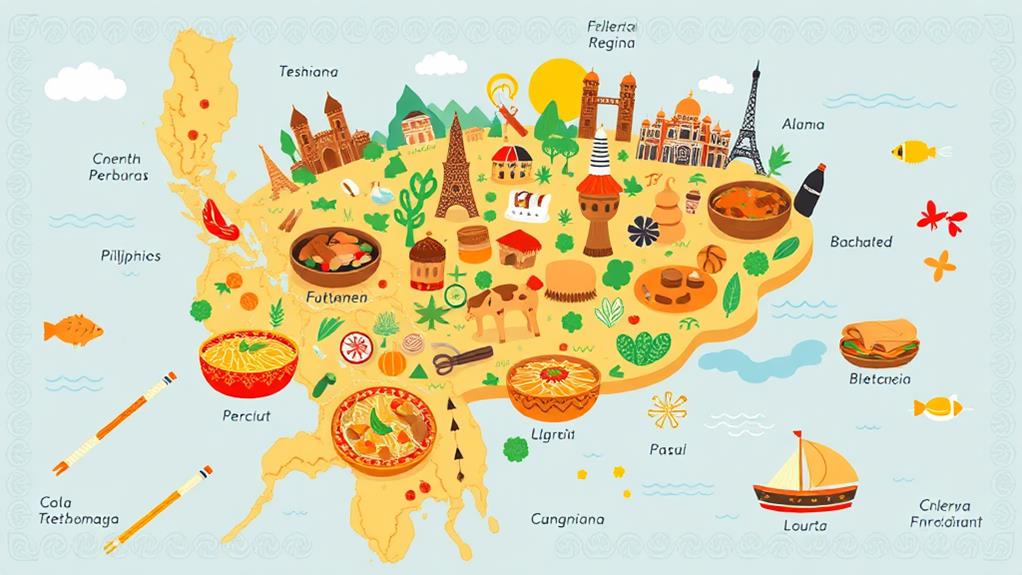
Regional Pancit Specialties
Each province and city in the Philippines puts its unique spin on pancit noodles.
In Bato, Camarines Sur, Pancit Bato stands out with its thick, sundried noodles and smoky flavors, often topped with shrimp, carrots, and bok choy in a savory vegetable broth.
Tuguegarao City's pancit variation is distinct. Pancit Batil Patong combines egg noodles with ground beef, chopped pork liver, and vegetables, served with a savory sauce.
Lucban, Quezon, has its own traditional pancit. Pancit Habhab features miki noodles, pork belly, and liver, along with sayote and carrots, flavored with a soy sauce-based seasoning.
Malabon's pancit is notable for its noodles. Pancit Malabon incorporates thick rice-flour noodles in a shrimp juice-based sauce.
Iloilo's pancit boasts a unique flavor profile. Pancit Chami features thick egg noodles stir-fried with a savory sauce, usually including a mix of meat, seafood, and vegetables.
Each region's unique twist is a testament to the versatility and richness of Filipino cuisine.
Comfort and Healing Pancit Dishes
Comfort and Healing Pancit Dishes
Beyond regional specialties, pancit dishes serve as comforting solace, providing warmth and nourishment during life's challenging moments. Pancit Langlang and Pancit Lomi are two comforting pancit dishes that hit the spot.
| Dish | Noodles | Toppings |
|---|---|---|
| Pancit Langlang | Miki | Onions, chicharron, shredded adobo meat |
| Pancit Lomi | Thick egg | Chicken, kikiam, meatballs, ham, hard-boiled eggs |
These comfort food variations of pancit emphasize the importance of flavorful broths and satisfying textures. The combination of hearty toppings like chicharron and meats, along with flavorful broths, provides warmth and nourishment. Nostalgia and warmth are key components of these comfort food variations.
These comfort food pancit dishes are often enjoyed during family gatherings, where their soothing qualities bring people together. The comforting nature of these dishes is attributed to their ability to evoke feelings of nostalgia and warmth.
Cultural Significance of Pancit
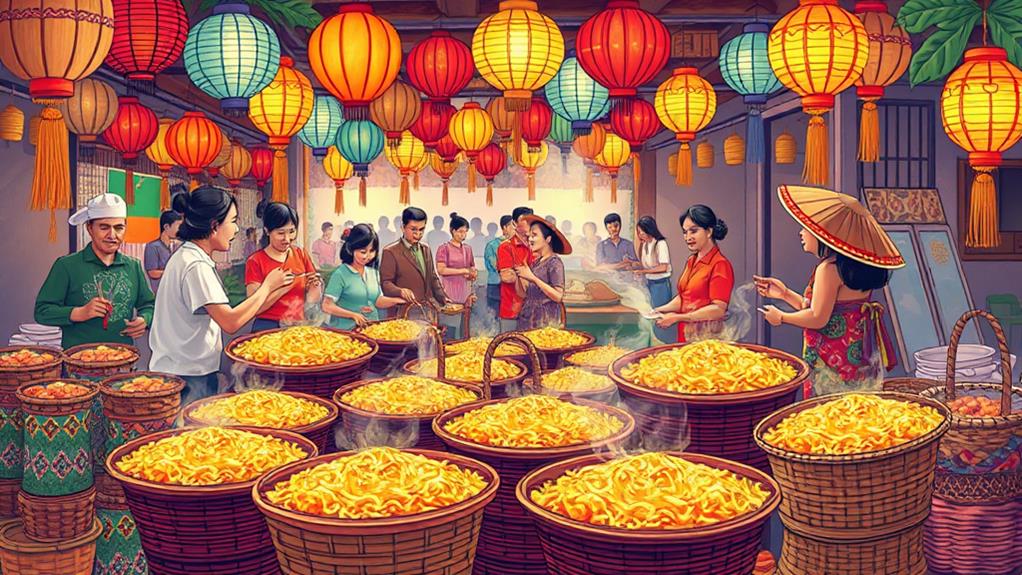
Pancit: A Symbol of Long Life and Good Fortune
In Filipino cultural traditions, pancit is served at birthday celebrations to symbolize long life and good fortune. This is because the term "pancit" itself is derived from Hokkien words for "wonton" and "convenient food," revealing the cultural exchange between Chinese merchants and Filipino locals.
Pancit's Evolution into a Quintessential Filipino Recipe
Pancit has evolved into a blend of Chinese influences and local flavors and ingredients, making it a staple in Filipino cuisine. This fusion represents comfort, community, and social connection. As a result, pancit is commonly featured at family gatherings, festivals, and religious events, bringing people together and strengthening social bonds.
Regional Variations of Pancit Showcase Filipino Culinary Heritage
The diverse regional variations of pancit demonstrate the rich culinary heritage of the Philippines. Each region offers unique interpretations that reflect local tastes and traditions.
For example, Pancit Lugaw from the Visayas region adds a flavorful twist with its use of annatto seeds and grilled pork.
Similarly, Pancit Molo from the Iloilo region features a rich broth made with pork and chicken stock.
Pancit's Role in Filipino Culture
In Filipino culture, food plays a vital part in fostering social connections and celebrating life's milestones.
Pancit's cultural significance is evident in its presence at various celebrations and gatherings, where it brings people together and strengthens social bonds.
By serving pancit, Filipinos demonstrate their appreciation for community, comfort, and good fortune.
Unique Presentation and Serving Styles
Presentation and serving styles of pancit elevate the dining experience. Each type of pancit has its own unique presentation, which adds to the overall appeal of the dish.
Pancit Habhab is traditionally served on banana leaves, allowing diners to eat with their hands, enhancing the communal experience of the meal.
Pancit Palabok features a vibrant presentation with its rich orange shrimp-infused sauce poured over thin, translucent rice noodles, garnished with hard-boiled eggs, scallions, and crispy chicharrón for added texture.
Other types of pancit, like Pancit Bato, offer a smokier flavor due to the use of sundried noodles, often topped with colorful vegetables and shrimp, making it visually appealing and flavorful.
Each type of pancit has its own unique presentation, making the experience of eating it even more enjoyable.
Pancit Chami and Its Rich Flavor
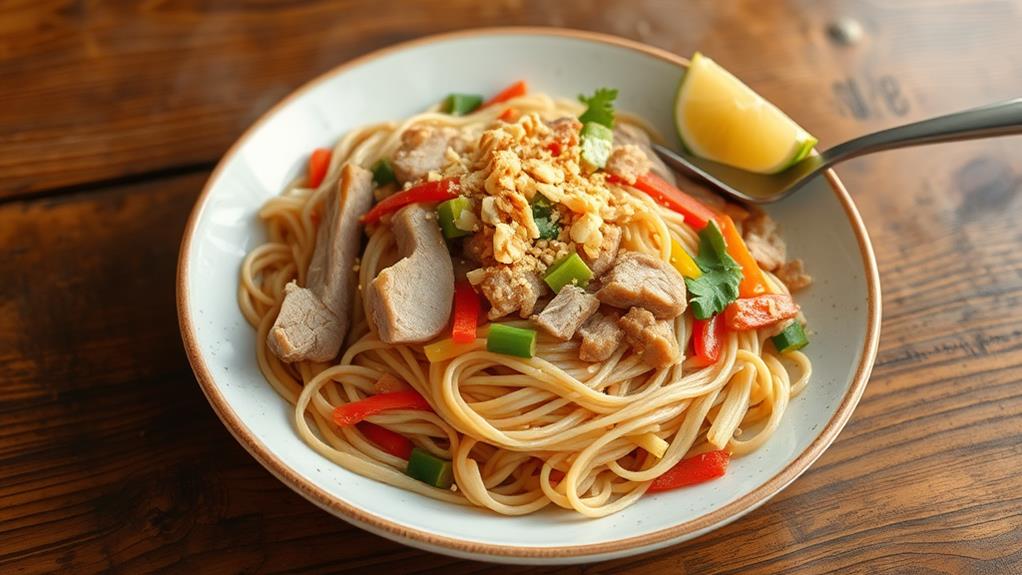
Pancit Chami: A Flavorful Twist on Traditional Pancit
Pancit Chami, originating from Iloilo City, stands out from other types of pancit due to its unique characteristics.
It is known for its thick egg noodles stir-fried in a savory sauce, which combines soy sauce, oyster sauce, and garlic. This distinct flavor profile is enhanced by the addition of various meats, such as chicken, pork, and shrimp, as well as vegetables like carrots and bell peppers.
The dish is garnished with green onions and sometimes topped with a fried egg, adding visual appeal and an extra layer of flavor. The balance of umami from the sauces and the freshness of the vegetables creates a rich flavor profile that has made Pancit Chami a beloved choice in local eateries.
This dish is often served during special occasions and gatherings, showcasing its significance in Filipino culinary traditions. With its rich flavor and appealing presentation, Pancit Chami is a must-try for anyone looking to experience the diversity of pancit.
Pancit as a Culinary Expression
Pancit as a Culinary Expression
Pancit is more than just a beloved Filipino dish; it's a rich tapestry of culinary expression that showcases the country's cultural diversity and adaptability.
The various types of pancit, such as Pancit Bihon and Pancit Canton, incorporate local ingredients and cooking techniques, reflecting the diverse culinary heritage of the Philippines. Each type utilizes distinct noodles and flavor profiles that highlight the cultural significance of the dish in Filipino celebrations and gatherings.
Pancit can be thought of as a canvas for culinary expression, allowing cooks to adapt recipes with different meats, vegetables, and sauces based on personal or regional preferences.
For example, Pancit Lomi, a fusion of Filipino and Chinese culinary traditions, illustrates the adaptation of noodles introduced by Chinese merchants to local tastes and ingredients.
This traditional Filipino dish reflects community identity and tradition, often passed down through generations, symbolizing not only nourishment but also connection to cultural roots and family history.
What are the key ingredients for popular types of Pancit?
Pancit is a popular Filipino noodle dish that comes in various types. The key ingredients for popular types of pancit include rice noodles, soy sauce, vegetables like carrots and cabbage, and protein such as chicken, pork, or shrimp. Each type of pancit offers a unique flavor and texture. Types of pancit explained.
Exploring Pancit's Nutritional Value
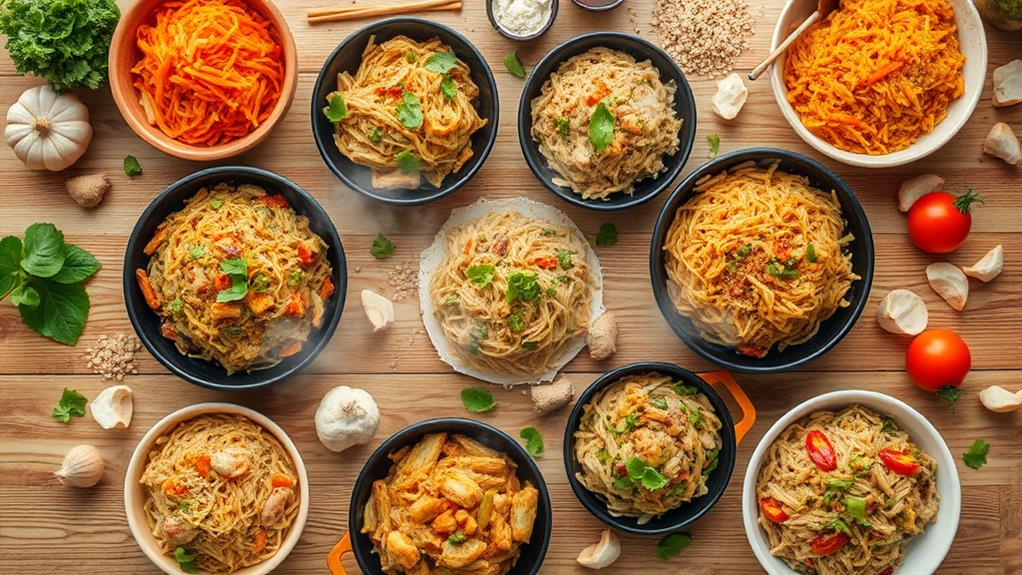
Measuring Pancit's Nutritional Value
Pancit's nutritional profile can fluctuate greatly due to its varied ingredients. A typical serving of Pancit Bihon provides approximately 605 calories, with 73.5 grams of carbohydrates, 22.8 grams of protein, and 23.6 grams of fat, making it a substantial meal option.
The Role of Vegetables in Pancit's Nutritional Value
The inclusion of vegetables in pancit recipes adds dietary fiber. A typical serving provides around 4.4 grams of fiber, supporting digestive health.
Vegetables like cabbage, carrots, and green beans not only add flavor but also contribute to the dish's nutritional value.
Customizing Pancit's Nutritional Value
You can enhance the nutritional value of pancit by adding ingredients like chicharrón (crispy pork skin), which boosts protein and fat content.
On the other hand, opting for low-sodium soy sauce can help manage sodium intake, as traditional recipes can contain around 494 mg of sodium per serving.
The type of rice used, such as glutinous or sticky rice, also influences pancit's nutritional value.
Frequently Asked Questions
What Is the Most Popular Type of Pancit?
Pancit Canton is the most popular type of pancit in Filipino cuisine. This dish has a rich history, and its egg noodles, vegetables, and savory sauces evoke memories of family gatherings and celebrations.
Different types of pancit, such as Bihon, Malabon, and Sotanghon, each have their unique story to tell, contributing to the cultural significance of pancit in Filipino culture.
However, Pancit Canton remains the favorite, a staple in many households, and a testament to the enduring appeal of this iconic dish.
What Is the Description of Pancit?
Pancit is a traditional Filipino dish that combines noodles, meat, and vegetables in a harmonious blend of flavors and textures.
This dish is more than just a stir-fry; it involves a variety of cooking techniques and regional variations. For instance, some recipes use steaming or boiling to cook the noodles, while others employ stir-frying or sautéing to combine the ingredients.
Pancit is a nutrient-rich food that provides a balance of carbohydrates, protein, and fiber. The noodles, typically made from rice flour or wheat flour, serve as a good source of carbohydrates. The meat, which can be chicken, pork, beef, or seafood, provides protein.
Vegetables like cabbage, carrots, and bean sprouts add fiber and essential vitamins.
Pancit has significant cultural importance in Filipino cuisine and is often served on special occasions. It's a staple dish at birthday celebrations, fiestas, and other gatherings, where it's shared with family and friends.
Pancit isn't just a meal, but an experience that brings people together and nourishes both body and soul.
Why Is Pancit Popular?
Pancit's cultural significance is the reason it has become an integral part of Filipino celebrations.
It symbolizes long life and prosperity, which is why it's often served during special occasions.
The dish has regional variations that reflect the country's diverse flavors, making it a staple at birthdays, anniversaries, and casual gatherings.
This adaptability has allowed pancit to bring people together, honoring traditions and solidifying its popularity across generations.
What Are the Most Popular Noodles in the Philippines?
The Philippines is home to a diverse range of noodle varieties, each with its unique flavor profile and texture.
In the Philippines, Bihon, thin rice noodles, and Lomi, thick egg noodles, are two popular examples of regional specialties.
Different noodle preparation techniques, such as stir-frying or souping, bring out the best in these noodles.
Regional noodle dishes can be found across the country, including Luzon, Visayas, and Mindanao.
Each region boasts its own specialty, showcasing the diversity of Filipino noodles.
